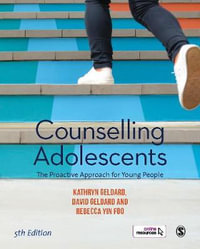
Environmental Psychology 2ed
An Introduction
By: Linda Steg (Editor), Judith I. M. de Groot (Editor)
Paperback | 11 January 2019 | Edition Number 2
At a Glance
448 Pages
25.5 x 18 x 2
Paperback
RRP $58.95
$39.25
33%OFF
or 4 interest-free payments of $9.81 with
orAims to ship in 7 to 10 business days
The updated edition of the essential guide to environmental psychology
Thoroughly revised and updated, the second edition, Environmental Psychology: An Introduction offers an overview of the interplay between humans and their environments. The text examines the influence of the environment on human experiences, behaviour and well-being and explores the factors influencing environmental behaviour, and ways to encourage pro-environmental behaviour. The revised edition is a state-of-the art review of relevant theories and research on each of these topics.
With contributions from an international panel of noted experts, the text addresses a wealth of topics including the main research methods in environmental psychology; effects of environmental stress; emotional impacts and meanings of natural environment experience; aesthetic appraisals of architecture; how to measure environmental behaviour; cognitive, emotional and social factors explaining environmental behaviour; effects and acceptability of strategies to promote pro-environmental factors; and much more. This important book:
- Discusses the environmental factors that threaten and promote human wellbeing
- Explores a wide range of factors influencing actions that affect environmental conditions
- Discusses the effects and acceptability of approaches that aim to encourage pro-environmental behavior
- Presents research results conducted in different regions in the world
- Contains contributions from noted experts
Written for scholars and practitioners in the field, the revised edition of Environmental Psychology offers a comprehensive review of the most recent research available in environmental psychology.
Industry Reviews
"This book is an interesting change from the usual run ofintroductions to environmental psychology. It dealsinteresting and thoroughly with a wide range of issues, andgenerally the many authors present their views and accounts ofresearch in a clear and easy-to-follow manner." (Psychology Learning & Teaching, 1 November 2013)
List of Figures xix
List of Tables xxi
List of Boxes xxii
List of Contributors xxiv
1 Environmental Psychology: History, Scope, and Methods 1
Linda Steg, Agnes E. van den Berg, and Judith I. M. de Groot
1.1 Introduction 2
1.2 History of the Field 2
1.2.1 Towards ‘Architectural’ Psychology 3
1.2.2 Towards a Green Psychology 4
1.3 Current Scope and Characteristics of the Field 4
1.3.1 Interactive Approach 4
1.3.2 Interdisciplinary Collaboration 5
1.3.3 Problem?Focused Approach 5
1.3.4 Diversity of Methods 6
1.4 Main Research Methods in Environmental Psychology 6
1.4.1 Questionnaire Studies 7
1.4.2 Laboratory Experiments 8
1.4.3 Computer Simulation Studies 8
1.4.4 Field Studies 9
1.4.5 Case Studies 9
1.5 Overview of the Book 10
Glossary 10
Suggestions for Further Reading 11
Review Questions 11
PART I ENVIRONMENTAL INFLUENCES ON HUMAN BEHAVIOUR AND WELL-BEING 13
2 Environmental Risk Perception 15
Gisela Bohm and Carmen Tanner
2.1 Introduction 16
2.2 What are Environmental Risks? 16
2.3 Subjective Risk Judgements 17
2.3.1 Heuristics and Biases in Risk Judgements 17
2.3.2 Temporal Discounting of Environmental Risks 19
2.3.3 The Psychometric Paradigm 19
2.4 Risk, Values, and Morality 19
2.4.1 Values 20
2.4.2 Morality and Ethics 21
2.5 Emotional Reactions to Environmental Risks 22
2.6 Summary 23
Glossary 23
Suggestions for Further Reading 24
Review Questions 25
3 Climate Change as a Unique Environmental Problem 26
Janet K. Swim and Lorraine Whitmarsh
3.1 Introduction 27
3.2 Public Understanding of Climate Change 27
3.3 Assessing the Risk of Climate Change 28
3.3.1 Detecting a Problem 30
3.3.2 Interpretations of Problems 31
3.3.3 Accepting Responsibility and Taking Action 32
3.4 Summary 33
Glossary 33
Suggestions for Further Reading 34
Review Questions 35
4 Environmental Stress 36
Elena Bilotta, Uchita Vaid, and Gary W. Evans
4.1 Introduction 37
4.2 Conceptualizations of Stress 37
4.3 Effects of Environmental Stress 38
4.3.1 Noise 38
4.3.2 Crowding 40
4.3.3 Poor Housing Quality 41
4.3.4 Poor Neighbourhood Quality 42
4.3.5 Traffic Congestion 42
4.4 Summary 43
Glossary 43
Acknowledgements 44
Suggestions for Further Reading 44
Review Questions 44
5 Scenic Beauty: Visual Landscape Assessment and Human Landscape Perception 45
Mari S. Tveit, Åsa Ode Sang, and Caroline M. Hagerhall
5.1 Introduction 46
5.2 Visual Quality Assessment 46
5.3 Theories Explaining Landscape Preferences as Innate or Learnt 47
5.4 Measuring and Mapping Scenic Beauty 50
5.5 Methodological Developments 51
5.6 Summary 52
Glossary 52
Suggestions for Further Reading 53
Review Questions 54
6 Health Benefits of Nature 55
Agnes E. van den Berg,Yannick Joye, and Sjerp de Vries
6.1 Introduction 56
6.2 What is Health and How can it be Measured? 57
6.3 What is Nature and How can it be Measured? 57
6.4 Nature and Clinical Health 58
6.5 Green Space and Public Health 59
6.6 Mechanisms Linking Nature to Health 60
6.6.1 Air Quality 61
6.6.2 Physical Activity 61
6.6.3 Social Cohesion 62
6.6.4 Stress Reduction 62
6.7 Summary 63
Glossary 63
Suggestions for Further Reading 64
Review Questions 64
7 Restorative Environments 65
Yannick Joye and Agnes E. van den Berg
7.1 Introduction 66
7.2 Restorative Environments Research 66
7.2.1 Stress Recovery Theory 67
7.2.2 Attention Restoration Theory 68
7.3 The Evolutionary Origins of Restorative Nature Experiences 69
7.4 Recent Theoretical and Empirical Developments 70
7.4.1 Perceptual Fluency Account 70
7.4.2 Connectedness to Nature 70
7.4.3 Micro?Restorative Experiences and Instorative Effects 72
7.5 Applications and Implications 72
7.6 Summary 73
Glossary 73
Suggestions for Further Reading 75
Review Questions 75
8 Ambivalence Towards Nature and Natural Landscapes 76
Agnes E. van den Berg and Cecil C. Konijnendijk
8.1 Introduction 77
8.2 Historical Overview 77
8.3 Emotional Impacts and Meanings of Natural Environment Experience 78
8.4 Views of Nature and Landscape Preferences 79
8.5 The Role of Biodiversity 80
8.6 An Existential?Motivational Account 81
8.7 Practical Implications 82
8.8 Summary 83
Glossary 83
Suggestions for Further Reading 84
Review Questions 84
9 Human Dimensions of Wildlife 85
Maarten H. Jacobs, Jerry J. Vaske, Tara L. Teel, and Michael J. Manfredo
9.1 Introduction 86
9.2 Early Work: Attitudes Towards Wildlife 86
9.3 The Cognitive Hierarchy 87
9.4 Wildlife Value Orientations 89
9.5 Predicting Norms and Attitudes Towards Wildlife 91
9.6 Emotions Towards Wildlife 91
9.7 Summary 93
Glossary 93
Suggestions for Further Reading 94
Review Questions 94
10 Children and the Natural Environment 95
Karin Tanja?Dijkstra, Jolanda Maas, Janke van Dijk?Wesselius, and Agnes van den Berg
10.1 Introduction 96
10.2 Childhood Experiences with Nature 96
10.3 Nature and Children’s Health and Well?Being 98
10.3.1 Physical Health Benefits 99
10.3.2 Mental Health Benefits 99
10.3.3 Cognitive Benefits 100
10.4 Childhood Nature Experiences and Adult Environmentalism 101
10.5 Applications and Implications 101
10.6 Summary 102
Glossary 102
Suggestions for Further Reading 103
Review Questions 103
11 Appraising and Designing Built Environments that Promote Well?Being and Healthy Behaviour 104
Robert Gifford and Lindsay J. McCunn
11.1 Introduction 105
11.2 Aesthetic Appraisals of Architecture 105
11.2.1 Uniformities in the Appraisal of Built Space 105
11.2.2 Observer Differences 107
11.2.3 Meaning in Architecture 108
11.3 Three Building Design Approaches that Promote Well?Being and Healthy Behaviour in Buildings 108
11.3.1 Social Design 108
11.3.2 Biophilic Design 110
11.3.3 Evidence?Based Design 111
11.4 Summary 111
Glossary 111
Suggestions for Further Reading 112
Review Questions 112
12 Urban Environmental Quality 113
Mirilia Bonnes, Massimiliano Scopelliti, Ferdinando Fornara, and Giuseppe Carrus
12.1 Introduction 114
12.2 Urban Settings as a Source of Stress and Discomfort 115
12.3 Urban Settings as a Source of Well?Being and Restoration 116
12.4 Residential Satisfaction – A Multicomponent Concept 117
12.5 A Multidimensional Approach to Urban Environmental Quality 117
12.6 The Multi?Place Approach 120
12.7 Summary 121
Glossary 121
Suggestions for Further Reading 122
Review Questions 122
13 Environment and Quality of Life 123
Goda Perlaviciute and Linda Steg
13.1 Introduction 124
13.2 QoL: Objective and Subjective Measures 125
13.3 QoL: Unidimensional and Multidimensional Measures 126
13.4 Environment and QoL: Research Overview 127
13.4.1 Which QoL Aspects are most Important? 127
13.4.2 To What Extent is QoL Sustained in Certain Situations? 129
13.4.3 How Does QoL Differ with Varying Environmental Conditions? 130
13.4.4 How Do Environmental Transformations Influence QoL? 131
13.5 Summary 133
Glossary 133
Suggestions for Further Reading 134
Review Questions 134
14 Place Attachment 135
Lynne C. Manzo and Patrick Devine?Wright
14.1 Introduction 136
14.2 Theories and Models of Place Attachment 137
14.2.1 Components of Place Attachment 137
14.2.2 Types of Place Attachments 138
14.2.3 Place Attachments Involve an Array of Emotions 138
14.2.4 Place Attachments as Dynamic and Socially Produced 139
14.3 Applications of Place Attachment 140
14.4 Summary 142
Glossary 142
Suggestions for Further Reading 143
Review Questions 143
15 How Cues in the Environment Affect Normative Behaviour 144
Siegwart Lindenberg
15.1 Introduction 145
15.2 Overarching Goals and their Relative Strengths 146
15.3 Environmental Cues that Directly Strengthen the Normative Goal 148
15.4 Environmental Cues that Directly Weaken the Normative Goal 149
15.5 Indirect Weakening of the Normative Goal by Environmental Cues that Strengthen the Gain Goal 150
15.6 Indirect Weakening of the Normative Goal by Environmental Cues that Strengthen the Hedonic Goal 151
15.7 Summary 152
Glossary 152
Suggestions for Further Reading 153
Review Questions 153
PART II FACTORS INFLUENCING ENVIRONMENTAL BEHAVIOUR 155
16 Measuring Environmental Behaviour 157
Birgitta Gatersleben
16.1 Introduction 158
16.2 What to Measure? Behaviour or Impact 158
16.2.1 Environmental Behaviour 158
16.2.2 Environmental Impact 159
16.3 How to Measure Environmental Behaviour? 162
16.4 Multidimensional or Unidimensional Measures of Environmental Behaviour 163
16.4.1 Multidimensional Measures of Environmental Behaviour 163
16.4.2 A Unidimensional Measure of Environmental Behaviour 164
16.5 Summary 165
Glossary 165
Suggestions for Further Reading 166
Review Questions 166
17 Values and Pro?Environmental Behaviour 167
Judith I.M. de Groot and John Thogersen
17.1 Introduction 168
17.2 Values 168
17.3 Value Theories 169
17.3.1 Social Value Orientations 169
17.3.2 Schwartz’s Value Theory 169
17.3.3 Four Key Values for Pro?Environmental Behaviour 171
17.4 How Values Affect Environmental Behaviour 173
17.5 Related Concepts 174
17.6 Practical Relevance of Value Research 176
17.7 Summary 176
Glossary 177
Suggestions for Further Reading 177
Review Questions 178
18 Social Norms and Pro?Environmental Behaviour 17
Kees Keizer and P. Wesley Schultz
18.1 Introduction 180
18.2 What is a Social Norm? 180
18.3 How Influential are Norms on Behaviour? 181
18.4 Why Do People Conform to Norms? 182
18.5 When Do Norms Influence Behaviour? 182
18.5.1 Salience 182
18.5.2 Group Size 183
18.5.3 Reference Groups 184
18.5.4 Personal Norms 184
18.5.5 Norm Conflict and the Importance of Aligned Messages 185
18.6 Summary 187
Glossary 188
Suggestions for Further Reading 188
Review Questions 188
19 Emotions and Pro?Environmental Behaviour 189
Danny Taufik and Leonie Venhoeven
19.1 Introduction 190
19.2 Emotions as a Motive for Action 191
19.3 Hedonic and Eudaimonic View on Emotions 192
19.4 Why Pro?Environmental Behaviour Elicits Positive Emotions: A Closer Look at the Eudaimonic View 194
19.5 Summary 196
Glossary 196
Suggestions for Further Reading 197
Review Questions 197
20 Symbolic Aspects of Environmental Behaviour 198
Birgitta Gatersleben and Ellen van der Werff
20.1 Introduction 199
20.2 Identity 199
20.2.1 Environmental Self?Identity and Behaviour 200
20.2.2 Factors Influencing Identity 201
20.3 Impression Management 203
20.4 Summary 205
Glossary 205
Suggestions for Further Reading 206
Review Questions 206
21 Social Dilemmas: Motivational, Individual, and Structural Aspects Influencing Cooperation 207
Chris von Borgstede, Lars?Olof Johansson, and Andreas Nilsson
21.1 Introduction 208
21.2 Defining Social Dilemmas 208
21.3 Types of Social Dilemmas 209
21.3.1 Large?Scale Dilemmas 209
21.3.2 Resource Dilemmas 209
21.3.3 Public Good Dilemmas 210
21.4 Motives in Social Dilemmas 210
21.4.1 Greed 210
21.4.2 Efficiency 211
21.4.3 Fairness 212
21.5 Factors Promoting Cooperation 212
21.5.1 Group Size 213
21.5.2 Communication 213
21.5.3 Response Efficacy 213
21.5.4 Environmental Uncertainty 214
21.5.5 Social Uncertainty 214
21.5.6 Norms in Large?Scale Dilemmas 214
21.6 Summary 215
Glossary 215
Suggestions for Further Reading 216
Review Questions 216
22 Theories to Explain Environmental Behaviour 217
Linda Steg and Annika Nordlund
22.1 Introduction 218
22.2 Theory of Planned Behaviour 218
22.3 Protection Motivation Theory 220
22.4 The Norm Activation Model 221
22.5 The Value?Belief?Norm Theory of Environmentalism 223
22.6 Goal?Framing Theory 224
22.7 Summary 225
Glossary 226
Suggestions for Further Reading 227
Review Questions 227
23 The Role of Group Processes in Environmental Issues, Attitudes, and Behaviours 228
Lise Jans and Kelly Fielding
23.1 Introduction 229
23.2 Why Should Environmental Psychologists be Interested in Group Processes? 229
23.3 How the Social Identity Approach Explains Environmental Conflict 230
23.4 Why Social Identity Guides Environmental Attitudes and Behaviours 231
23.4.1 Group Norms Guide Environmental Attitudes and Behaviours 232
23.4.2 Group Members Influence Environmental Attitudes and Behaviours 233
23.4.3 Group Identification Influences Environmental Attitudes and Behaviours 234
23.5 Why Social Identity can Affect Cooperation on Environmental Issues 234
23.6 How the Social Identity Approach Explains Environmental Group Formation 235
23.7 Summary 236
Glossary 236
Suggestions for Further Reading 237
Review Questions 237
24 Yesterday’s Habits Preventing Change for Tomorrow? About the Influence of Automaticity on Environmental Behaviour 238
Christian A. Klockner and Bas Verplanken
24.1 Introduction 239
24.2 Theoretical Background: How Habits are Acquired 240
24.3 Narrowing Down Decision?Making: How Habits Affect Information Use 241
24.4 Measuring Habits: A Challenge for Research 243
24.5 Breaking Bad Habits, Creating Good Habits: Interventions Changing Routine Behaviour 246
24.6 Summary 248
Glossary 248
Suggestions for Further Reading 249
Review Questions 250
25 Environmental Psychology in Latin America 251
Javier Urbina?Soria and Emilio Moyano?Diaz
25.1 Introduction 252
25.2 Latin American Background 252
25.3 Past Reviews on Environmental Psychology in Latin America 253
25.4 Recent Developments in Environmental Psychology in Latin America 254
25.5 Key Issues for the Development of Research in Latin America 256
25.5.1 Lack of Collaboration 256
25.5.2 Few Possibilities to Publish in Spanish or Portuguese 257
25.5.3 Academic Training in Environmental Psychology 257
25.6 Summary 258
Glossary 258
Suggestions for Further Reading 259
Review Questions 259
PART III ENCOURAGING PRO-ENVIRONMENTAL BEHAVIOUR 261
26 Informational Strategies to Promote Pro?Environmental Behaviour: Changing Knowledge, Awareness, and Attitudes 263
Wokje Abrahamse and Ellen Matthies
26.1 Introduction 264
26.2 Interventions: From Research to Implementation 264
26.3 Informational Strategies 265
26.3.1 Provision of Information 265
26.3.2 Goal Setting 266
26.3.3 Commitment 267
26.3.4 Prompting 268
26.3.5 Feedback 268
26.4 Intervention Research: Some General Issues 269
26.5 Summary 270
Glossary 271
Suggestions for Further Reading 271
Review Questions 272
27 Encouraging Pro?Environmental Behaviour with Rewards and Penalties 273
Jan Willem Bolderdijk, Philip K. Lehman, and E. Scott Geller
27.1 Introduction 274
27.2 Analysis of Consequences 274
27.3 Natural Versus Extra Consequences 276
27.4 When is it Appropriate to Apply Extra Consequences? 277
27.5 How Should Extra Consequences be Announced and Delivered? 278
27.5.1 Negative Versus Positive Consequences 279
27.5.2 Monetary Versus Non?Monetary Consequences 279
27.6 Summary 281
Glossary 281
Suggestions for Further Reading 282
Review Questions 282
28 Persuasive Technology to Promote Pro?Environmental Behaviour 283
Cees Midden and Jaap Ham
28.1 Introduction 284
28.2 Technology and Behaviour 284
28.3 Persuasive Technology 285
28.4 Approaches to Applying Persuasive Technology 286
28.5 Social Influence through Smart Systems 287
28.5.1 The Role of Social Cues 287
28.5.2 Reactance 288
28.6 Providing Persuasive Experiences 289
28.7 Persuasive Technology as a Tool to Promote Behaviour Change 289
28.7.1 Ambient Persuasion 290
28.7.2 Group Interventions 291
28.8 Summary 292
Glossary 293
Suggestions for Further Reading 293
Review Questions 294
29 Acceptability of Environmental Policies 295
Geertje Schuitema and Cecilia J. Bergstad
29.1 Introduction 296
29.2 Acceptability as a Social Dilemma 296
29.3 Theoretical Framework to Explain the Acceptability of Policy Measures 297
29.3.1 Individual Policy Outcomes 298
29.3.2 Collective Policy Outcomes 298
29.3.3 Fair Distribution of Policy Outcomes 300
29.4 Procedural Fairness and Acceptability of Environmental Policies 302
29.5 How can Public Support Increase Over Time? An Illustration 303
29.6 Summary 305
Glossary 305
Suggestions for Further Reading 306
Review Questions 306
30 Processes of Change 307
Sebastian Bamberg and Maxie Schulte
30.1 Introduction 308
30.2 Lewin’s Theory of Change 308
30.3 Behavioural Change: A Self?Regulation Process Steered by Feedback Loops 309
30.3.1 Goals as Reference Values in a Feedback Loop 309
30.3.2 Hierarchical Organization of Goals and Feedback Loops 309
30.3.3 The Importance of Self?Focus 311
30.4 Behavioural Change: It Takes Time to Overcome Resistance to Change 311
30.5 The Stage Model of Self?Regulated Behavioural Change 312
30.6 Implications for Interventions 314
30.7 Empirical Validation of the SSBC 315
30.8 Summary 316
Glossary 317
Suggestions for Further Reading 318
Review Questions 318
31 Simulating Social Environmental Systems 319
Wander Jager and Nick Gotts
31.1 Introduction 320
31.2 An Introduction to Social Complexity 320
31.3 Social Simulation as a Methodology 321
31.4 Social Simulation of Environmental Behaviour 322
31.4.1 Using Theory in Simulation Models: Formalizing Processes of Attitude Change 322
31.4.2 Using Theory and Data in Models: Diffusion of Environmental Innovations 323
31.5 Integrating Social Simulation into Environmental Modelling 324
31.5.1 The Lakeland Study 324
31.5.2 Companion Modelling: A Study of Rice Production and Labour Migrations in North?East Thailand 325
31.5.3 Integrating Multiple Models of a Socioenvironmental System: Water Use in the Danube Basin 326
31.6 Key Steps in Building Agent?Based Models 327
31.6.1 Development of Models 327
31.6.2 Using Models 327
31.7 Summary 328
Glossary 328
Suggestions for Further Reading 329
Review Questions 329
32 Environmental Issues in Low? and Middle?Income Countries 330
Nadja Contzen, Hans?Joachim Mosler, and Silvie Kraemer?Palacios
32.1 Introduction 331
32.2 Environmental Risk Perception, Environmental Concern, and Climate Change Perception 331
32.2.1 Environmental Risk Perception 331
32.2.2 Environmental Concern 332
32.2.3 Climate Change Perception 332
32.3 Residential Environment and Well?Being 333
32.3.1 Slums and Public Housing 333
32.3.2 Communal Spaces 334
32.3.3 Rural Communities 334
32.4 Behaviour and Behaviour Change 334
32.4.1 Resource Conservation 335
32.4.2 Sustainable Transportation 335
32.4.3 Recycling 335
32.4.4 Water, Sanitation, and Hygiene 337
32.5 Summary 338
Glossary 339
Suggestions for Further Reading 339
Review Questions 340
33 Conclusion: Summary, Trends, and Future Perspectives in Environmental Psychology 341
Agnes E. van den Berg and Linda Steg
33.1 Summary and Key Findings 342
33.1.1 Part I: Environmental Influences on Human Behaviour and Well?Being 342
33.1.2 Part II: Factors Influencing Environmental Behaviour 343
33.1.3 Part III: Encouraging Pro?Environmental Behaviour 344
33.2 General Trends and Developments 345
33.2.1 Positive Interactions Between Humans and Environments 345
33.2.2 Integrative Approaches 346
33.2.3 From One Psychology to Multiple Psychologies 346
33.3 Challenges for Future Research 347
33.3.1 Further Integration 348
33.3.2 Further Development of Theories and Methods 349
33.3.3 Further Engagement 349
Glossary 351
Suggestions for Further Reading 351
Review Questions 351
References 352
Index 407
ISBN: 9781119241089
ISBN-10: 1119241081
Series: BPS Textbooks in Psychology
Published: 11th January 2019
Format: Paperback
Language: English
Number of Pages: 448
Audience: Professional and Scholarly
Publisher: John Wiley & Sons (UK)
Country of Publication: US
Edition Number: 2
Dimensions (cm): 25.5 x 18 x 2
Weight (kg): 0.94
Shipping
| Standard Shipping | Express Shipping | |
|---|---|---|
| Metro postcodes: | $9.99 | $14.95 |
| Regional postcodes: | $9.99 | $14.95 |
| Rural postcodes: | $9.99 | $14.95 |
How to return your order
At Booktopia, we offer hassle-free returns in accordance with our returns policy. If you wish to return an item, please get in touch with Booktopia Customer Care.
Additional postage charges may be applicable.
Defective items
If there is a problem with any of the items received for your order then the Booktopia Customer Care team is ready to assist you.
For more info please visit our Help Centre.
You Can Find This Book In

Eye Movement Desensitization and Reprocessing (EMDR) Therapy
Basic Principles, Protocols, and Procedures 3rd Edition
Hardcover
RRP $161.00
$138.00
OFF

Psychology, 6e ANZ & An Interactive Approach to Writing Essays and Research Reports in Psychology 5e Value Pack
Multi-Copy Pack
RRP $191.95
$161.50
OFF

Polyvagal Flip Chart
Understanding the Science of Safety (Norton Series on Interpersonal Neurobiology)
Paperback
RRP $57.95
$38.50
OFF

Diagnostic and Statistical Manual of Mental Disorders 5/e TR (DSM-5-TR)
Diagnostic and Statistical Manual of Mental Disorders
Hardcover
RRP $347.00
$306.90
OFF

Creative Ways to Help Children Manage BIG Feelings
A Therapist's Guide to Working with Preschool and Primary Children
Paperback
RRP $66.99
$57.50
OFF


















